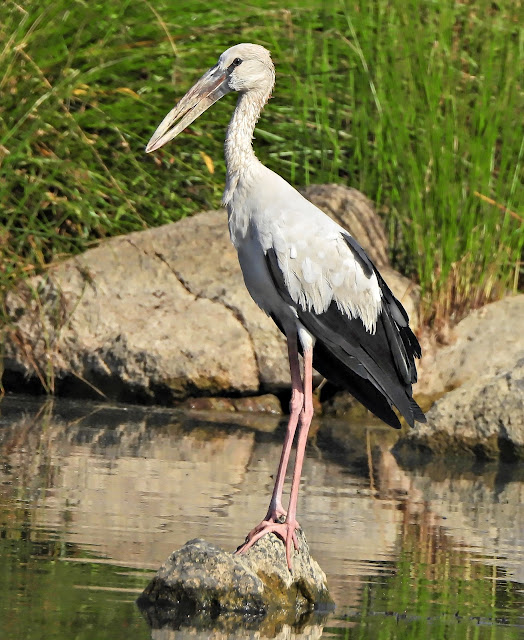The Asian openbill or Asian openbill stork (Anastomus oscitans ) is a large wading bird in the stork family Ciconiidae. This distinctive stork is found mainly in the Indian subcontinent and Southeast Asia. It is greyish or white with glossy black wings and tail and the adults have a gap between the arched upper mandible and recurved lower mandible. Young birds are born without this gap which is thought to be an adaptation that aids in the handling of snails, their main prey. Although resident within their range, they make long distance movements in response to weather and food availability.
The Asian openbill stork is predominantly greyish (non-breeding season) or white (breeding season) with glossy black wings and tail that have a green or purple sheen. The name is derived from the distinctive gap formed between the recurved lower and arched upper mandible of the beak in adult birds. Young birds do not have this gap. The cutting edges of the mandible have a fine brush like structure that is thought to give them better grip on the shells of snails.
The tail consists of twelve feathers and the preen gland has a tuft. The mantle is black and the bill is horn-grey. At a distance, they can appear somewhat like a white stork or Oriental stork. The short legs are pinkish to grey, reddish prior to breeding. Non-breeding birds have a smoky grey wings and back instead of white. Young birds are brownish-grey and have a brownish mantle. Like other storks, the Asian openbill is a broad-winged soaring bird, which relies on moving between thermals of hot air for sustained flight. They are usually found in flocks but single birds are not uncommon. Like all storks, it flies with its neck outstretched. It is relatively small for a stork and stands at 68 cm height (81 cm long).
The usual foraging habitats are inland wetlands and are only rarely seen along river banks and tidal flats. On agricultural landscapes, birds forage in crop fields, irrigation canals, and in seasonal marshes. Birds may move widely in response to habitat conditions. Young birds also disperse widely after fledging.
Individuals ringed at Bharatpur in India have been recovered 800 km east and a bird ringed in Thailand has been recovered 1500 km west in Bangladesh. Storks are regularly disoriented by lighthouses along the southeast coast of India on overcast nights between August and September. The species is very rare in the Sind and Punjab regions of Pakistan, but widespread and common in India, Sri Lanka, Nepal, Bangladesh, Myanmar, Thailand and Cambodia. It has recently expanded its range into southwestern China.




